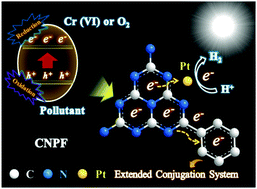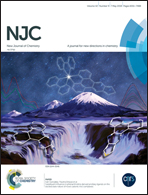Preparation of phenyl group functionalized g-C3N4 nanosheets with extended electron delocalization for enhanced visible-light photocatalytic activity†
Abstract
As a polymer semiconductor, the intrinsic structure (melon units) of graphitic carbon nitride (g-C3N4) can be modified by a facile co-polymerization approach. However, compared to the intensive research on doping or constructing a heterostructure etc., developing a co-polymerization strategy for improving the photocatalytic performance of g-C3N4 has received much less attention, owing to the lack of an appropriate polymerization route being exploited to introduce organic motifs into carbon nitride networks. In the present work, benzamide is employed as a new, low-cost co-monomer of urea to prepare the phenyl group functionalized g-C3N4 (CNPF) through a convenient one-pot thermal induction process. Introducing a phenyl group into the melon frame can essentially extend the original π-conjugation system of g-C3N4, leading to the improved visible light utilization and increased separation rate of electron–hole pairs. Furthermore, adding some benzamide into urea during the polymerization process enriches the pore structure of the as-obtained CNPF samples, resulting in a larger specific surface area. Under visible light irradiation, the as-prepared CNPF exhibits superior catalytic activity in a variety of photocatalytic systems, such as hydrogen generation from water, photo-degradation of dye and photo-reduction of Cr(VI).



 Please wait while we load your content...
Please wait while we load your content...